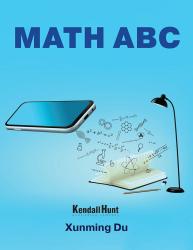MATH ABC
Author(s): Xunming Du
Edition: 1
Copyright: 2022
Pages: 158
Choose Your Platform | Help Me Choose
Math ABC is written in an innovative way as it makes readers learn basic math knowledge with a fresh and pleasant experience.
Arithmetic with actual meaning will be easy to understand. For example, a young mom may find it difficult to explain to his son why 2-(-1) is 2+1, which equals 3. However, if she tells her son the difference between 2 degree and negative 1 degree in temperature is 3 with a thermometer. Her son may understand the operation right away. The subtraction to find the difference is to add one unit to 2 since the distance between 2 and negative 1 is 3. Chapter one basically teaches Arithmetic in this way. The chapter covers absolute values, fraction operations, order of operations, decimals, percents, scientific notations, and exponents.
After Arithmetic, chapter two talks about Algebra. Algebra in Chinese is translated to “daishu.” That means “using a letter, which is called a variable, to express an unknown number.” The chapter covers how to find an unknown number, or how to find solutions in equations and inequalities. Polynomial concept is introduced in the chapter. The popular confusion is that in front of an unknown number denoted by the letter “x,” the number is “0” since there is nothing in front of “x.” This is wrong since “0” times “x” is “0.” The correct answer is “1” since “1” times any number is that number. The author has video clips located in the nearby contents with QR codes for the explanations. Students may find these very handy when the video clips pop up on their cell phones after scanning the QR codes with the phone camera.
The third feature of the textbook is animations and graph or text toggling in the textbook. Teachers might find it very useful when doing presentations about the function concept in chapter three. When projecting the page of a function concept on a white board, teachers may make a certain pair of numbers appear and disappear to emphasize the connection of these two numbers. Teachers can also make good connections between points on a graph and the point coordinate calculations. Graphing animations will stick the function concept to a student's mind for a long time with such innovative teaching. Chapter three covers the linear functions and quadratic functions besides the addition techniques.
The fourth feature of the text is readers might start to read anywhere in the text. It is just like readers reading a novel. One reason to make it possible, of course, is that readers can always trigger the video lectures since everything is video explained. The other reason might be the hyperlinks in the text make the cross-references possible. From the table of contents, readers may click the page number to go to a desired section or a quiz. For going back, readers may either click the section title or press “Alt”+”left arrow” in PC, “command”+”left arrow” in MAC. Page numbers are clickable as well in Index. Readers may see a terminology explanation easily by clicking the nearby page number.
Readers may always test themselves by doing quizzes after each unit. Quizzes are automatically graded by clicking “End.” The correct answers are given by clicking “Correct” at the end of each quiz. For non multiple choice questions, the correct answer will show up in the “Correct answers” box after clicking “Ans” behind each fill-in blank question.
1 Real Numbers
1.1 Numerical Axis and Real Numbers
1.2 Math and English
Quiz1
Quiz2
Quiz3
1.3 Arithmetic Operations and Absolute Values
Quiz1
Quiz2
1.4 Fractions and Order of Operations
Quiz1
Quiz2
1.5 Fractions, Decimals, Percents, and Scientific Notations
Quiz1
Quiz2
Quiz3
1.6 Exponent
Quiz1
Quiz2
Quiz3
Quiz4
2 Equations, Inequalities, and Polynomials
2.1 Solving One Variable Equations
Quiz1
Quiz2
2.2 Polynomials
2.2.1 Addition, Subtraction, and Multiplication
2.2.2 Factoring Polynomials
2.2.3 Solving Equations by Factoring
2.2.4 Quadratic Formula
Quiz1
Quiz2
2.3 Inequalities
Absolute Value Inequalities
Quiz1
Quiz2: Condition “and”
Quiz3: Condition “or”
Quiz4: Absolute Value Inequalities
3 Functions and Addition Techniques
3.1 Linear Equation
Quiz1
Quiz2
Quiz3
3.2 Graphs of Quadratic Functions
Quiz1
Quiz2
3.3 Addition Techniques
3.3.1 General Sequence
Quiz
3.3.2 Geometric Sequence
Quiz
4 Radicals, Rational Related, Equation Systems
4.1 Radicals and Rational Exponents
Quiz1
Quiz2
Quiz3
4.2 Rational Expressions and Equations
Quiz1
Quiz2
4.3 Systems of Linear Equations
Quiz
Index
Xunming Du, the author of Math ABC, was the recipient of the Regents’ Creative Activities Awards on March 2, 2018. This award, established in 1993 by the Regents, recognizes significant accomplishments which bring recognition, as well as national and international stature, to the Nevada System of Higher Education.
Xunming has been a professor of mathematics at Great Basin College (GBC) since 2003. He holds a master’s degree in medical statistics from Tongji Medical University, China, and a master’s degree in mathematics from Ohio University. Prior to coming to GBC, Xunming taught medical statistics and other mathematics courses to undergraduate and graduate students in China and Ohio. His publications include “A Note of Wavelet Variance,” published in 2008 in the journal “Communications in Statistics – Theory and Methods.”
His creative labor of love has been his electronic textbook for pre-calculus. The text allows students to interact with embedded graphs, tables, and videos to enhance the learning process.
Math ABC is written in an innovative way as it makes readers learn basic math knowledge with a fresh and pleasant experience.
Arithmetic with actual meaning will be easy to understand. For example, a young mom may find it difficult to explain to his son why 2-(-1) is 2+1, which equals 3. However, if she tells her son the difference between 2 degree and negative 1 degree in temperature is 3 with a thermometer. Her son may understand the operation right away. The subtraction to find the difference is to add one unit to 2 since the distance between 2 and negative 1 is 3. Chapter one basically teaches Arithmetic in this way. The chapter covers absolute values, fraction operations, order of operations, decimals, percents, scientific notations, and exponents.
After Arithmetic, chapter two talks about Algebra. Algebra in Chinese is translated to “daishu.” That means “using a letter, which is called a variable, to express an unknown number.” The chapter covers how to find an unknown number, or how to find solutions in equations and inequalities. Polynomial concept is introduced in the chapter. The popular confusion is that in front of an unknown number denoted by the letter “x,” the number is “0” since there is nothing in front of “x.” This is wrong since “0” times “x” is “0.” The correct answer is “1” since “1” times any number is that number. The author has video clips located in the nearby contents with QR codes for the explanations. Students may find these very handy when the video clips pop up on their cell phones after scanning the QR codes with the phone camera.
The third feature of the textbook is animations and graph or text toggling in the textbook. Teachers might find it very useful when doing presentations about the function concept in chapter three. When projecting the page of a function concept on a white board, teachers may make a certain pair of numbers appear and disappear to emphasize the connection of these two numbers. Teachers can also make good connections between points on a graph and the point coordinate calculations. Graphing animations will stick the function concept to a student's mind for a long time with such innovative teaching. Chapter three covers the linear functions and quadratic functions besides the addition techniques.
The fourth feature of the text is readers might start to read anywhere in the text. It is just like readers reading a novel. One reason to make it possible, of course, is that readers can always trigger the video lectures since everything is video explained. The other reason might be the hyperlinks in the text make the cross-references possible. From the table of contents, readers may click the page number to go to a desired section or a quiz. For going back, readers may either click the section title or press “Alt”+”left arrow” in PC, “command”+”left arrow” in MAC. Page numbers are clickable as well in Index. Readers may see a terminology explanation easily by clicking the nearby page number.
Readers may always test themselves by doing quizzes after each unit. Quizzes are automatically graded by clicking “End.” The correct answers are given by clicking “Correct” at the end of each quiz. For non multiple choice questions, the correct answer will show up in the “Correct answers” box after clicking “Ans” behind each fill-in blank question.
1 Real Numbers
1.1 Numerical Axis and Real Numbers
1.2 Math and English
Quiz1
Quiz2
Quiz3
1.3 Arithmetic Operations and Absolute Values
Quiz1
Quiz2
1.4 Fractions and Order of Operations
Quiz1
Quiz2
1.5 Fractions, Decimals, Percents, and Scientific Notations
Quiz1
Quiz2
Quiz3
1.6 Exponent
Quiz1
Quiz2
Quiz3
Quiz4
2 Equations, Inequalities, and Polynomials
2.1 Solving One Variable Equations
Quiz1
Quiz2
2.2 Polynomials
2.2.1 Addition, Subtraction, and Multiplication
2.2.2 Factoring Polynomials
2.2.3 Solving Equations by Factoring
2.2.4 Quadratic Formula
Quiz1
Quiz2
2.3 Inequalities
Absolute Value Inequalities
Quiz1
Quiz2: Condition “and”
Quiz3: Condition “or”
Quiz4: Absolute Value Inequalities
3 Functions and Addition Techniques
3.1 Linear Equation
Quiz1
Quiz2
Quiz3
3.2 Graphs of Quadratic Functions
Quiz1
Quiz2
3.3 Addition Techniques
3.3.1 General Sequence
Quiz
3.3.2 Geometric Sequence
Quiz
4 Radicals, Rational Related, Equation Systems
4.1 Radicals and Rational Exponents
Quiz1
Quiz2
Quiz3
4.2 Rational Expressions and Equations
Quiz1
Quiz2
4.3 Systems of Linear Equations
Quiz
Index
Xunming Du, the author of Math ABC, was the recipient of the Regents’ Creative Activities Awards on March 2, 2018. This award, established in 1993 by the Regents, recognizes significant accomplishments which bring recognition, as well as national and international stature, to the Nevada System of Higher Education.
Xunming has been a professor of mathematics at Great Basin College (GBC) since 2003. He holds a master’s degree in medical statistics from Tongji Medical University, China, and a master’s degree in mathematics from Ohio University. Prior to coming to GBC, Xunming taught medical statistics and other mathematics courses to undergraduate and graduate students in China and Ohio. His publications include “A Note of Wavelet Variance,” published in 2008 in the journal “Communications in Statistics – Theory and Methods.”
His creative labor of love has been his electronic textbook for pre-calculus. The text allows students to interact with embedded graphs, tables, and videos to enhance the learning process.




